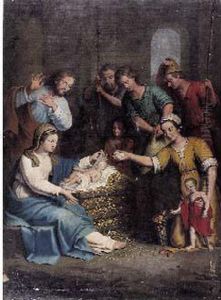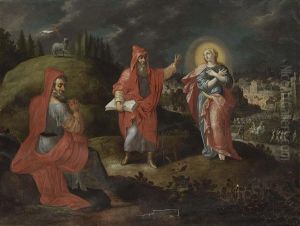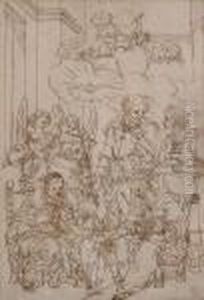Englebert Fisen Paintings
Englebert Fisen was a prominent artist born in 1655 in the city of Liège, which was then part of the Prince-Bishopric of Liège, a state within the Holy Roman Empire, and is now located in modern-day Belgium. His artistic journey began in his hometown, where he initially trained. The period in which Fisen lived was characterized by the Baroque style, which greatly influenced his artistic development. However, detailed records of his early training and the specific influences on his work during his formative years are sparse. Like many artists of his time, Fisen's style evolved through the study of both local and international art, blending traditional Flemish elements with the emerging trends of the Baroque movement.
Fisen is best known for his contributions to religious and portrait painting, a common focus for many artists of the Baroque era, who sought to capture the emotional depth and dynamic movement characteristic of the period. His works are notable for their vibrant use of color, attention to detail, and the emotional expressiveness of the figures he depicted. Fisen's religious paintings, in particular, reflect the Counter-Reformation's emphasis on using art as a means of religious instruction and inspiration, aiming to engage viewers on both an intellectual and emotional level.
Throughout his career, Fisen enjoyed the patronage of the church and local nobility, which was a significant achievement for artists of his time. This support not only allowed him to work on large-scale commissions but also contributed to his reputation and legacy. His portraits of the local elite are particularly valued for their insight into the cultural and social dimensions of 17th and early 18th-century Liège.
Despite his success, Englebert Fisen remains a somewhat obscure figure in the broader spectrum of European art history. His works are primarily found in local museums and churches, and while they exemplify the Baroque style's richness and complexity, they have not received the same level of international recognition as those of his contemporaries in neighboring countries. Fisen passed away in 1733 in Liège, leaving behind a body of work that continues to be appreciated for its contribution to the Baroque movement in the Low Countries.
The study of Englebert Fisen's life and work offers valuable insights into the regional variations of Baroque art and the role of artists in the cultural and religious life of their communities. His legacy is a testament to the vibrant artistic scene of Liège in the 17th and early 18th centuries, reflecting the unique blend of local traditions and broader European artistic movements of the time.


